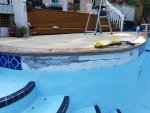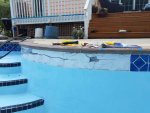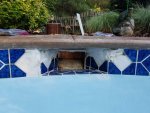I have an outside curve that usually loses some tiles each winter due to freeze-thaw. (The pool isn't closed in winter.) This time I lost/took down 6 LF of tile and also some tile around one of the skimmers. (Pictures below.)
I have chiseled out all the rotten thinset and rotten underlying plaster/concrete. Everything that is left is extremely solid. If I try to chisel off the remaining thinset I end up taking out 1/2-3/4 inch of plaster/concrete with it. The underlying plaster/concrete is from an earlier repair of a construction defect (the beam didn't go all the way up to the coping) so I would prefer to not disturb it. (The coping is poured concrete.)
I cut down some high spots on the old thinset, scuffed the thinset with a wire wheel and put an acidic tile cleaner on the thinset to try and etch it.
The cracks in the beam are stable. I ran a blade down them to open them up for patching.
I don't have a grinder, but could get one if needed.
My plan is to fill in the holes with E-Z Patch plaster to create a level surface, attach the tile with E-Z Patch thinset and then use E-Z Patch grout.
I would appreciate opinions as to whether I can use new thinset over the remaining old thinset to attach the tiles. The stretch of tiles that was removed is on the side of the pool nearest the house, so if the tiles end up a little high it won't be very noticeable.
To try and extend the life of the repair this time, I am planning to use Quikrete Concrete Bonding Adhesive between the existing concrete/plaster and the E-Z Patch plaster. (Slurry coat, 2 parts Portland cement & 1 part Bonding Adhesive)
I would also appreciate opinions as to whether there would be any benefit from putting some of the Concrete Bonding Adhesive (plain, as a primer) on the back of the tiles. The Concrete Bonding Adhesive is supposed to dramatically increase the strength of the bond between concrete and plaster, but I think it has to be absorbed into the substrate. I'm not sure this would happen with ceramic tile.
E-Z Patch recommended using their E-Z Patch 22 Silicone Rubber (comes in a caulking tube) for both adhesive and grout on this repair since outside curves are apparently notorious for having tiles pop off. I decided to stay traditional (this time), but has anybody had any experience with this product?
Thanks!



I have chiseled out all the rotten thinset and rotten underlying plaster/concrete. Everything that is left is extremely solid. If I try to chisel off the remaining thinset I end up taking out 1/2-3/4 inch of plaster/concrete with it. The underlying plaster/concrete is from an earlier repair of a construction defect (the beam didn't go all the way up to the coping) so I would prefer to not disturb it. (The coping is poured concrete.)
I cut down some high spots on the old thinset, scuffed the thinset with a wire wheel and put an acidic tile cleaner on the thinset to try and etch it.
The cracks in the beam are stable. I ran a blade down them to open them up for patching.
I don't have a grinder, but could get one if needed.
My plan is to fill in the holes with E-Z Patch plaster to create a level surface, attach the tile with E-Z Patch thinset and then use E-Z Patch grout.
I would appreciate opinions as to whether I can use new thinset over the remaining old thinset to attach the tiles. The stretch of tiles that was removed is on the side of the pool nearest the house, so if the tiles end up a little high it won't be very noticeable.
To try and extend the life of the repair this time, I am planning to use Quikrete Concrete Bonding Adhesive between the existing concrete/plaster and the E-Z Patch plaster. (Slurry coat, 2 parts Portland cement & 1 part Bonding Adhesive)
I would also appreciate opinions as to whether there would be any benefit from putting some of the Concrete Bonding Adhesive (plain, as a primer) on the back of the tiles. The Concrete Bonding Adhesive is supposed to dramatically increase the strength of the bond between concrete and plaster, but I think it has to be absorbed into the substrate. I'm not sure this would happen with ceramic tile.
E-Z Patch recommended using their E-Z Patch 22 Silicone Rubber (comes in a caulking tube) for both adhesive and grout on this repair since outside curves are apparently notorious for having tiles pop off. I decided to stay traditional (this time), but has anybody had any experience with this product?
Thanks!





